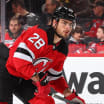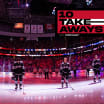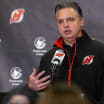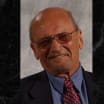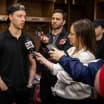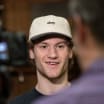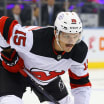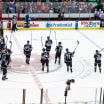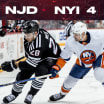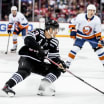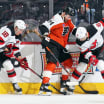Devils strength and conditioning coach Joe Lorincz and his staff were in Buffalo, N.Y., for the physical testing portion of the 2017 NHL Scouting Combine last week. Here he shares how he interprets that data and uses it to provide the team's scouts with better insight - and help make the players the team selects better athletes.
Ten questions with strength and conditioning coach Joe Lorincz
Devils strength and conditioning coach Joe Lorincz and his staff were in Buffalo, N.Y., for the physical testing portion of the 2017 NHL Scouting Combine last week.
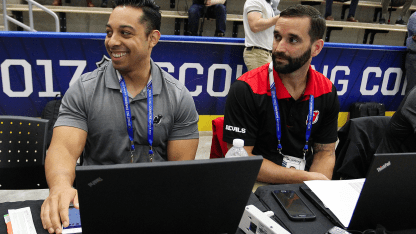
By
Julie Robenhymer @JulieRobenhymer / newjerseydevils.com
Q: What do you get out of being at the combine?
A: The league puts all the data online and they film everything in a very high resolution video. You can go back after the fact and pull up someone's results and watch video of every single test and exercise they did. So while it's nice to see it happen firsthand and helps you size these prospects up in person, that's just one part of it. It's more of an opportunity for all of the strength coaches to get together and have some meetings about the combine and what we're doing for testing and how we can make it better, and even just to share ideas while we're sitting there watching these kids.
Q: You mentioned making the combine better. How has it changed over the years?
A: The combine hasn't been around that long and it's changed a lot. At my first one eight years ago, there was a mishmash of testing in the ballroom of a hotel in Toronto. You couldn't see everything because there were all these pillars and just way too many tests. It wasn't ideal. The strength coaches that have been in the league for a long time have done an awesome job working with the league to whittle it down to what the strength coaches believe are the key tests.
Q: What is discussed in meetings with the other strength coaches?
A: What do we want to change? What do we want to see next year? How do we think things were run? How can we make things better? In the past, they would bring in college students to do the testing and things might not have been explained properly to the prospects. Now we have professionals overseeing the tests, so we know everything has been executed properly and the data is more valid. So it's really just an opportunity for the strength coaches to come together and agree on what we want to see tested and how we want to test it. … Now, there are less than 10 actual tests and they all do it in the same order, and we've even separated the two bike tests to be done on different days to get more accurate results.
Q: What value do you get out of all the data and the videos?
A: What you're looking for is: One, how they move. Do they look really awkward or are they nice and smooth? Are they naturally athletic? Two, are they prepped for the test? You can tell with some of these kids that they have no clue what they're doing so you know that their testing numbers are pretty raw because he's untrained, but then there are other kids who you know have worked with strength coaches and know exactly how to do the test. That's something you have to consider when comparing the data.
Q: Would you rather see a kid that's prepared as opposed to someone coming in raw?
A: I don't know. I go back and forth about that. If you have a kid that's raw and he's untrained and unprepared, you know he's got all that potential and hope it's not a sign of a poor work ethic, but that's a really good question. I ask [Devils head coach John] Hynes and the scouts that question all the time. Personally, I think on-ice performance should obviously be the biggest factor. I mean, if you want to know if someone's a good hockey player, watch them play hockey. Don't watch them do pull-ups. But if you have two guys with comparable on-ice skills and one is more untrained in the weight room, I'd lean towards that guy because we know he has room for improvement and could possibly get even better on the ice. But again, that's not my decision to make.
Q: If you could only have one test, which would you pick and why?
A: My instinct would be to lean towards the pro-agility - the shuttle test - just because that's the most athletic, skill-based test. The more a test resembles the skill that they need to do in their sport, the more it will help you predict their future performance. If you're looking at something like sprinting speed or, in our case, skating speed, the broad jump would be a better indication of their ability than vertical jump, which is still a good indication of power, but broad jump is better just because it occurs horizontally and so do skating and running. So in saying that, the pro-agility test holds the most value for me because you're controlling your body weight, accelerating, decelerating, changing direction. It's very explosive, occurs in a tight area and that's exactly what happens in ice hockey.
Q: What do you do with all this data?
A: Obviously, we evaluate all the data including their power scores, vertical jumps and pro-agility and the broad jump. If a player dominated all four tests, you know he's powerful, and if he didn't, you know he's not. But 80 percent of players fall somewhere in the middle. Let's say one guy had a great vertical, but a poor broad jump and he was good on the pro-agility, but his Wingate wasn't as strong. What is he? We record all this information to pass along to our scouts.
Q: So basically, you make your own scouting list?
A: Yes, exactly. The numbers are very objective and the subjective part of it comes in my comments based on what I saw - if I feel like this athlete was prepped for this test or that he was really raw. I send all that to Paul [Castron, Devils director of amateur scouting] so they can add it to everything else they have on these players. They just tell me the information they want to get out of these tests, which is always the same thing. They want to know who is explosive and who has potential for growth, who's going to be a good skater, who's going to be able to put on some weight and add some strength. Not only do I compare the prospects this year, but I also take the past two years of data to make even more comparisons and hopefully provide a little more clarity.
Q: How does this information help you develop them after the draft?
A: We'll bring them in during development camp and do our own testing. It's very similar to the tests done at the combine, but at least at this point you kind of know everyone's on the same page. That's another concern with the results from the combine. Some kids might have been on the ice last week, while some haven't played in two months. That's going to make a difference. Plus, we're able to accurately compare them to our other prospects and then we can set them up with a plan to help make their weak points stronger.
Q: Looking ahead to development camp next month, what is your focus there?
A: We just want to teach them what it's like to be a professional hockey player. I don't really train them throughout the week with the intention of making them better in that week, but I design the workouts to show them how we train in New Jersey and how they should be training once they get back home. During the past in camp, we have had cooking classes and a nutritionist seminar, so that once they turn pro and they're living on their own, they know how to feed themselves. It's basically a weeklong lesson in how to be a pro, and allow the kids a chance to get to know each other as well as the staff


